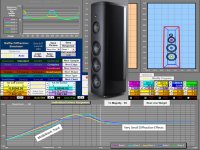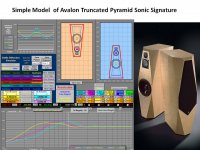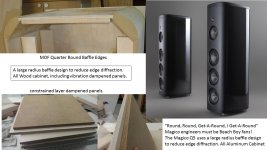Just wondering, in simple and basic, what measurements, or modeling, etc determines this ?
That is somewhat too general an inquiry. For most people, the baffle width is determined by the size of the woofer. Then there is diffraction and baffle step correction both are affected by the size and shape of the baffle. This topic can go on and on so I would suggest your inquiry should be a bit more specific.
That is somewhat too general an inquiry. For most people, the baffle width is determined by the size of the woofer. Then there is diffraction and baffle step correction both are affected by the size and shape of the baffle. This topic can go on and on so I would suggest your inquiry should be a bit more specific.
Agree. Plus.
Some prefer the imaging/presentation of a slim speaker (they are in your room) to the imaging/presentation of a wide baffle speaker (you are in their room)
Some would argue that slim baffles are down to fashion trends and WAF (Wife acceptance factor)
Some would argue that slim baffles are down to fashion trends and WAF (Wife acceptance factor)
That is probably more true than any other "principles". OP better off asking his wife or facebook.
Just wondering, in simple and basic, what measurements, or modeling, etc determines this ?
You should search for 'baffle step'.
I am about to build a 3 way active, Pro driver, DSP pair of speakers. I know the cabinet volumes already. I plan on putting the mid and AMT as close together as possible. So now I have 2 trains of thought, and would like to know which I should go with .... and why?
I can build the cabinet just over the width of the mid, and round over the cabinets 3/4".
Or, I can build the cabinets the same width of the mid, but on either side of the mid, I can start a large 1.5" round over, like this:
 [/url]20171206_160832 by Cullen Graham, on Flickr[/IMG]
[/url]20171206_160832 by Cullen Graham, on Flickr[/IMG]
This has a HUGE smooth round over, but makes the cabinet 3" wider.
I can build the cabinet just over the width of the mid, and round over the cabinets 3/4".
Or, I can build the cabinets the same width of the mid, but on either side of the mid, I can start a large 1.5" round over, like this:

This has a HUGE smooth round over, but makes the cabinet 3" wider.
That is probably more true than any other "principles". OP better off asking his wife or facebook.
Oh, ok. So you are saying it doesn't much matter. Never been on Facebook ... never will. My wife of 33 years is gone. So I had to ask here instead.
Oh, ok. So you are saying it doesn't much matter. Never been on Facebook ... never will. My wife of 33 years is gone. So I had to ask here instead.
My apology to your personal situation.
As for the baffle size and shape, if you want to optimize to the nth degree then I guess it's your call. But what you have is probably "good" enough. I think at the end of the day, driver selection and xover design are probably overwhelmingly more important than any effect of the baffle, that is given the baffle is something reasonable like what you have in the picture.
I love facebook and be there everyday.
"Round, Round,
Get A-Round,
I get A-Round"
You cannot go wrong using advice from the Beach Boys.
----------
Baffle diffraction simulations show that large rounds on all front baffle edges, plus careful driver placement, will significantly smooth the SPL response, and also simplify the crossover circuit(function).
Bevels which create a truncated pyramid baffle like Avalon speakers significantly reduce edge diffraction but still add some "dither" to the in-room SPL response. Does a little dither trigger the imagination?
---------------
Cabinet Design = When in doubt, copy off of the smart kids.
Get A-Round,
I get A-Round"
You cannot go wrong using advice from the Beach Boys.
----------
Baffle diffraction simulations show that large rounds on all front baffle edges, plus careful driver placement, will significantly smooth the SPL response, and also simplify the crossover circuit(function).
Bevels which create a truncated pyramid baffle like Avalon speakers significantly reduce edge diffraction but still add some "dither" to the in-room SPL response. Does a little dither trigger the imagination?
---------------
Cabinet Design = When in doubt, copy off of the smart kids.
Attachments
I wonder if there is a point where it is neither one nor the other, and then what determines the impression, does it require a conscious leap of faith like Rubin's Vase?Some prefer the imaging/presentation of a slim speaker (they are in your room) to the imaging/presentation of a wide baffle speaker (you are in their room)
Flaxxer?, Your not getting much of what your lookin for in the way of answers are you?
You didn't ask about compromise, Or "Good enough".
Go with the HUGE Round-over! You cannot go wrong!
My speakers have a 4' radius. 2' wide. And i love them!~
"Your" priorities determine what factors are important for the design of said baffle.
There are entire books on the subject. Just like aircraft design.
My priority has always been sound quality.
You didn't ask about compromise, Or "Good enough".
Go with the HUGE Round-over! You cannot go wrong!
My speakers have a 4' radius. 2' wide. And i love them!~
"Your" priorities determine what factors are important for the design of said baffle.
There are entire books on the subject. Just like aircraft design.
My priority has always been sound quality.
Now I realize, why there seems to be confusion. I am brand new to speaker building. So I was originally posting to find out at what stage of the design process, and what people normally use to determine their baffle shape and size?
I'm not sure if it is something you get from Holm Response results, or modeling in a program, or if it is actually something the designer gets to choose out of his imagination. Or if it is determined by some other set of measurements. I really have no clue.
I'm just trying to learn. Seems it is less important than other aspects, as long as you keep to sound principals, such as roundovers, Avalon types, etc.
I'm not sure if it is something you get from Holm Response results, or modeling in a program, or if it is actually something the designer gets to choose out of his imagination. Or if it is determined by some other set of measurements. I really have no clue.
I'm just trying to learn. Seems it is less important than other aspects, as long as you keep to sound principals, such as roundovers, Avalon types, etc.
Last edited:
Yes, I have read about baffle step. What it seems to mean to me, is that you can correct for the freq issues in the xover, and there are charts which show you the frequencies at different widths.
So I guess you can go with what baffle width you want, and just correct for where the freq levels differ.
So I guess you can go with what baffle width you want, and just correct for where the freq levels differ.
Yes. The narrower the baffle the more correction. Also the nearer the front wall the less correction. Narrow baffle is largely to do with fashion, and generally speaking the wider the baffle the less diffraction. So, you need to weigh up the pros and cons and decide on your priorities.
Last edited:
You ask what shape. Do you mean flat panel vs funneled as a horn or rolled back? A baffle controls the sound. It can be used to direct it within a room. Where control is taken it should be handed back.
Or do you mean the shape of the flat front panel, which matters less if you round its edges?
Or do you mean the shape of the flat front panel, which matters less if you round its edges?
The 'c' does not stand for correction, it stands for compensation. If your lower midrange goes behind your speaker, it won't just disappear.go with what baffle width you want, and just correct for
I wonder if there is a point where it is neither one nor the other, and then what determines the impression, does it require a conscious leap of faith like Rubin's Vase?
Interesting question. I think very wide baffle speakers like Troels strad copy might offer something in between?
This is a good read, OP might be interested in it too.
Infinite-baffle
- Status
- This old topic is closed. If you want to reopen this topic, contact a moderator using the "Report Post" button.
- Home
- Loudspeakers
- Multi-Way
- What determines baffle size and shape?


